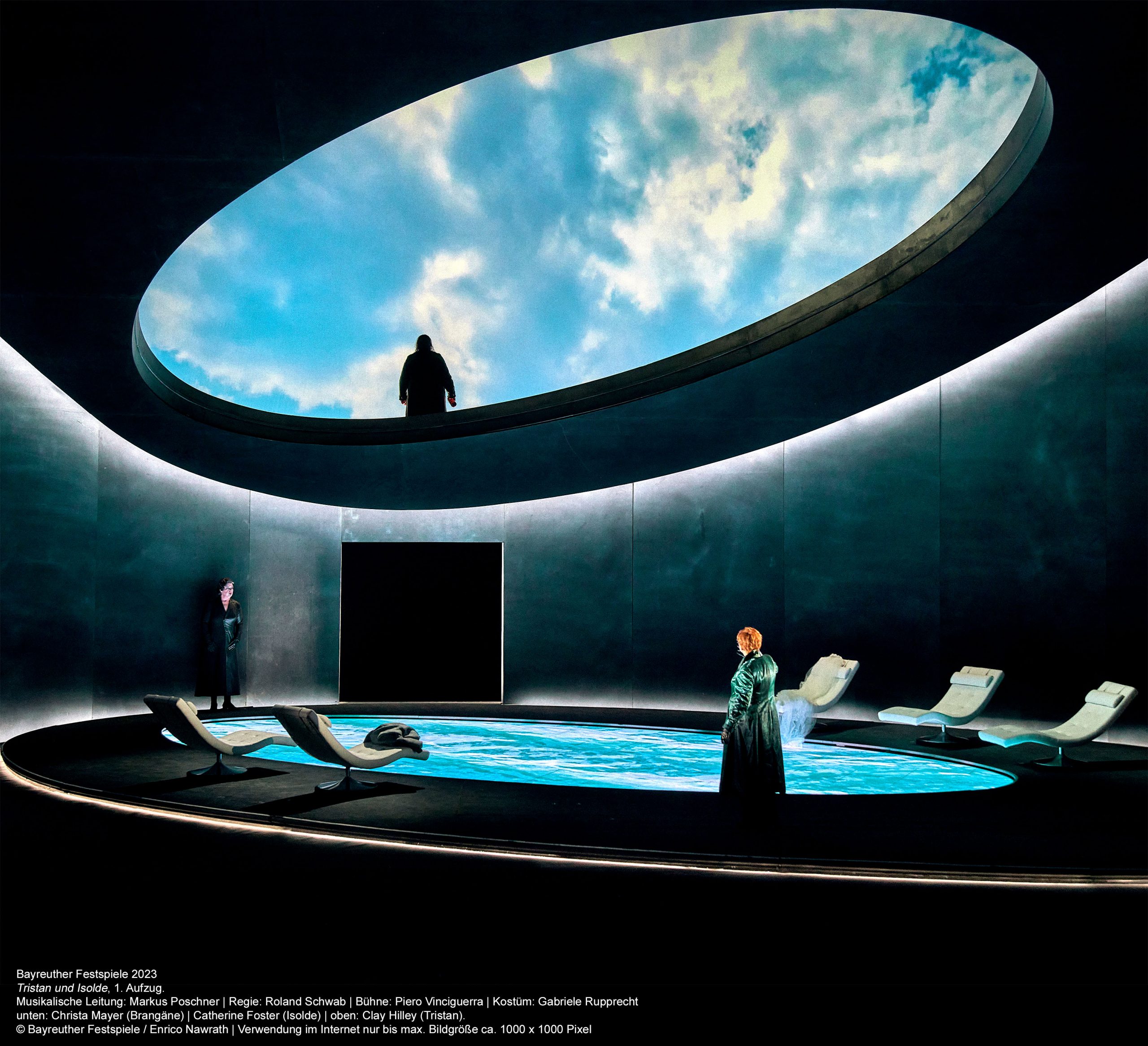
Now in its second season at this Wagnerian wonderland, director Roland Schwab’s Tristan und Isolde has again proven to be a favourite of the Bayreuth audience and this year – and that is without the context of contrasting with a seemingly deeply unpopular production of Der Ring des Nibelungen.
There is always the risk with Regietheater (perhaps a curse of Bayreuth in modern times) that the cult of the director subsumes the music and the singers. Thankfully, this is not the case with this modern yet sympathetic, intellectually stimulating and emotionally charged production.

Yes, it is a reasonably safe concept of eternity (helped with a red Sanskrit illumination throughout the work), the overture with two children, two teenagers appearing when the lovers are absorbed almost literally in one another as the whirlpool of time engulfs them, and then an elderly couple appearing at the very end.

The set from Schwab and design collaborator Piero Vinciguerra is not a Ring but an ellipse (could it be a planet’s orbit or just the sea-going vessel?), with this oval chamber opening to the starry heavens or an ever changing sky, while a similar shape on the floor is like a cruise ship’s luxury pool with sunbeds. It is around this that the characters walk while a video changes it to a swirling vortex, at one stage a human eye, at others blood red slowly filling the waters. This is all, of course, in response to the actions that take place or stories that are told. Also, of course, only Tristan and Isolde can walk onto / into this vortex where they sing and perform their Act Two love duet until discovered by Melot and the sanctuary is breached. It then becomes a torture chamber for Tristan and ultimately where he dies in Act Three and Isolde brings the story to its conclusion with Liebestod.
This oval shaped space had a terrace framing one side of the sky-opening (the upper level of the cruise ship?) , and it is here that we first meet our Tristan, where Brangane watches out for the return of King Marke, where the teenagers appear, and the exquisitely shepherd pipe solos enchant us. The lighting by Nicol Hungsberg also makes fine use of shadow and the effect of lanterns / spotlights that are shone to interrogate and humiliate the lovers and a blinding white portal at the rear of this oval.

Together the theatricality, intricate lighting and use of video, the period mixing costumes, and Schwab’s direction melds into a work that has distinct yet complementary approaches; a cosmic New Age experience with near hallucination-inducing visual effects, conceptual symbolism, and then sufficient naturalist interaction to create human characters in a heart-wrenching tale.
There is no denying the acclaim given to British soprano Catherine Foster as a majestic Isolde. Dramatically and vocally, she runs the gamut of fury and bitterness to ecstasy and sublimity. Her voice has the strength and security to match its darkness and rich beauty. That stamina is evident as she sweeps all before her from the momentous demands of Act One, the intensity of Act Two love duets to a Liebestod to die for.

The American tenor Clay Hilley’s Tristan shows not only the power and sustained energy needed to sing Tristan, but artistry to interpret the role. Like Foster, this dramatic tenor sang with heroic gravity and clarity and achieved all of this while fulfilling some theatrical requirements on that ever-changing floor that had my head swirling just watching from my own vantage point for this transcendental experience.
Festival favourite Georg Zeppenfeld sang the role of King Marke with a gorgeous bass that was equally intoxicating as Daland in Hollander and Gurnemanz in Parsifal on the following two evenings. This wonderful singer delivers a heartfelt and calm performance, with immaculate legato as a despondent king who has been betrayed but finds the ability to forgive.

The Act ends with Tristan being wounded not by a blow of any kind but by a no doubt deeply symbolic set of lights descending on to him as he sits in the chair in some hypnotic state. In the final scene the wounded Tristan is surrounded by candles as well as more of those weird and wonderful cosmic lights for his gargantuan aria.
Kurvenal, was delightfully sung by German lyrical baritone Markus Eiche, bringing out the loyalty and final despair at Tristan’s plight. At the end of the opera, he lies dead alongside Tristan, as King Marke also sinks down to take his dead hero’s hand.

The audience quite rightly adored the Brangäne beautifully and delicately sung by Christa Mayer who gave an elegant and sensitive portray of the pivotal, if foolhardy role. Her showpiece arias were amongst the most moving of the evening.
Melot was sung as a deeply sinister character wielding that interrogation spotlight, by the strong Icelandic baritone Olafur Sigurdarson.

It was with an apparent consummate partnership of pit and stage, music and concept, that Markus Poschner gave a reading of the score that had perfect moments of stillness and silence that in this searing work are vital to give space and context to the intensely strong and emotion-filled passages.
A tale of Nordic revenge, Die fliegende Hollander, Bayreuth Festival:
Theatrical genius, Tannhauser, Bayreuth Festival:
Doubly surreal Parsifal, Bayreuth Festival